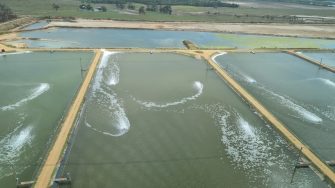
Date: Tuesday, November 3, 2020
Project: Eastern Australian Waterbird Survey
Observers: Richard Kingsford UNSW, John Porter UNSW/DPIE
Pilot: James Barkell NSW National Parks & Wildlife Service (DPIE)
We departed Maroochydore with some very welcome blue sky, into survey band 7 to count several freshwater dams to the west and then the river and estuarine lakes near Noosa. There were low numbers of birds on these wetlands – We found a few egrets, black swans and pelicans on the dams and some terns, pelicans and silver gulls on the estuarine wetlands. Lake Weyba seldom has many waterbirds and our low count on this wetland and the Noosa River is not unusual.
Counting under grey skies over Myall Lakes
Counting on Lake Weyba
Developments around these coastal waterbodies has accelerated in recent years making some sites difficult to survey, since we are restricted in how close to built-up areas we can go. One of the strengths of our long term survey program is being able to identify where impacts like these have led to changes (often declines) over time
Counting at the Mouth of the Noosa River
From Noosa we headed to survey band 8 and some small wetlands north of Bundaberg – the Burnett River estuary, Littabella and Baffle Ck systems as well as a couple of aquaculture pond systems. Again, we found only small numbers of birds, mostly egrets, terns and a few cormorants.
Aquaculture ponds north of Bundaberg
Next up we flew into Gladstone to refuel before setting course for the floodplain creeks and billabongs of Herbert Creek & the Styx River – in good conditions these wetlands can support many thousands of waterbirds, often with great diversity.
Counting on Herbert Creek floodplain
Most of the floodplain wetlands contain only moderate amounts of water with low numbers of birds present – mainly black duck, grey teal and egrets together with a few masked lapwings, glossy ibis and black swans.
South of Proserpine are the Proserpine plains – mostly natural creeks and billabongs with a few dams and reservoirs. Most of these wetlands are drying or only partly full with low to moderate numbers of waterbirds. On one dam there are a few hundred of black duck and grey teal, with smaller numbers of other species including lapwings, herons, egrets and magpie geese.
Blog by John Porter
